Drug Misuse in Children and Young People
Last Modified 28/03/2023 13:28:49
Share this page
Introduction
The use of drugs by children and young people presents both short and long term risks to health and wellbeing, with these risks varying by the type of substances taken1. Regular use of illicit drugs is not a common feature of most young people’s lives, and for many of those who do use drugs, their use is experimental and ‘recreational’, often waning in early adulthood. However, for some young people their use can become problematic and can lead to long term heavy use1,2. Even with low level, occasional use there are health risks associated with adverse reactions, adulterated substances, polydrug use and overdose.
The mental health of young people who take drugs is a particular concern, both in terms of the impact of drug use on an individual’s mental health and of the potential increased use of drugs among those experiencing mental health difficulties1,3.
As Dame Carol Black’s 2020 Review of Drugs highlighted4, estimated drug use among those aged 11 to 15 increased by 40% between 2014 and 2018 following a long-term downward trend. Since 2018 estimated prevalence has reduced, though remains above 2014 levels. The number of young people accessing drug treatment across England has decreased by over 40% since 2009/10. Those who do access treatment may have complex needs, including poor mental health, self-harm, offending and experience of sexual exploitation4,5. Dame Carol Black's review also highlights the increasing risk of young people becoming involved in drug supply and ‘county lines’ networks, further increasing their vulnerability to drug use, violence, exploitation and criminalisation.
Blackpool addresses the substance misuse needs of the population through a range of inter-related strategies and services. In addition to the issues, needs and responses to children and young people's drug misuse outlined below, please also see the following:
The Prevalence of Drug Use Among Children and Young People
Estimating the prevalence of children and young people’s drug use can be difficult due to a range of factors, from access, confidentiality and safe disclosure, to the comparability of different approaches, reliability of self-reporting surveys and the extent to which surveys are representative. Because of this, prevalence estimates tend to be presented on a national level.
Prevalence is also recorded and reported at various frequencies, often in terms of whether a person has ever used a drug, or used it in the last year or month. The following information is primarily based on reported used of illicit drugs in the last year. Since this can include occasional use, someone trying a substance, and frequent use (e.g. daily or weekly) it should not be considered to be the prevalence level of 'regular use' among children and young people.
Under 16s
The primary source of drug prevalence estimates among under 16s is the biennial schools survey 'Smoking, drinking and drug use among young people in England' conducted by NHS Digital / Ipsos Mori with school pupils in years 7 to 11 (mostly 11 to 15 year olds).
The latest survey was conducted in 2021 after a three year gap due to COVID-19. It found that overall prevalence of illicit drug use reduced during the COVID-19 period:
- 18% of pupils reported having ever used an illicit substance (down from 24% in 2018 and 2016). Reported ever use was higher among girls (19%) than boys (17%) for the first time in the survey's history. Reported prevalence of 'ever-use' increases with age, from 7% among 11 year olds to 32% among 15 year olds.
- 12% reported using illicit drugs in the last year (17% in 2018), 11% of boys and 13% of girls. 3% of 11 year olds reported illicit drug use in the last year compared to 24% of 15 year olds.
- 6% reported taking drugs in the last month (9% in 2018), the same proportion for girls and boys. 2% of 11 year olds reported use in the last month compared to 13% of 15 year olds (the 15 year old proportion in 2018 was 19%).
- Cannabis was the most commonly reported illicit substance tried or used, with 7% of all those surveyed having ever taken the drug, and 2.9% reporting use within the last month. Volatile substance use (glue, gas, aerosols and solvents) was the next common (6.8% ever use, 1.2% in the last month), followed by nitrous oxide and new psychoactive substances (both 0.9% in last month).
- Pupils who recently smoked, drank alcohol and took drugs were more likely to report low levels of wellbeing / life satisfaction (57%) compared to pupils who had done one of these (35%) and those who have done none (18%).
- Of those who had taken drugs on more than one occasion, 50% of those took drugs on the most recent occasion 'to get high or feel good' (up from 42% in 2018), whilst 27% did so 'to forget my problems' (up from 19% in 2018).
As Figure 1 highlights, prevalence estimates based on this survey show a downward trend in young people's drug use until 2014, when reported use rose sharply. The 2021 survey shows a decline over the Covid-19 period, however proportions remain higher that 2014 levels.
Figure 1: Proportion of Young People Reporting Illicit Drug Use (Ever Use, Last Year and Last Month), NHS Digital Survey, 2001 to 2021
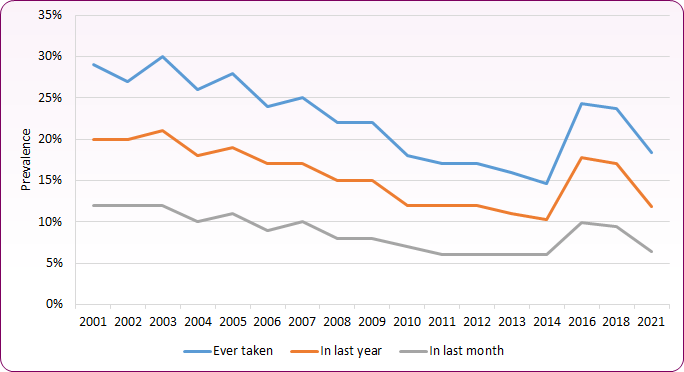 Source: NHS Digital, Smoking, Drinking and Drug Use among Young People in England, 2021
Source: NHS Digital, Smoking, Drinking and Drug Use among Young People in England, 2021
16 to 24 Year Olds
Among young adults (aged 16 to 24), the 2019/20 Crime Survey for England and Wales (CSEW) found that across England and Wales the proportion of those reportedly using an illicit drug in the last year fell between 2003/4 and 2012/13 before increasing once more. In 2019/20:
- 21% of 16 to 19 year olds had used ‘any drug’ in the last year, compared to a low of 16.5% in 2016/17.
- 21% of 20 to 24 year olds had also used ‘any drug’ in the last year compared to a low of 16.4%% in 2012/13 (Figure 2).
- the proportion of young people aged 16 to 24 reporting use of any illicit substance in the last month was 9.9%
- the proportion reporting frequent use (use of any drug more than once in the past month) was 4.3%, slightly below the average over the past five years (4.5%).
Figure 2: CSEW Proportion Reporting Use of Any Illicit Drug in Last Year, Ages 16 to 19 and 20 to 24, England and Wales, 2001/02 to 2019/20
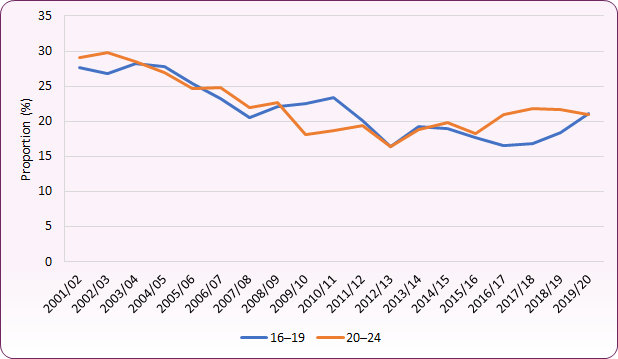 Source: Office for National Statistics, Drug Misuse Appendix Tables: Findings from the year ending March 2020 Crime Survey for England and Wales
Source: Office for National Statistics, Drug Misuse Appendix Tables: Findings from the year ending March 2020 Crime Survey for England and Wales
The most commonly used illicit drug among under 25s is cannabis, with 19.2% of 16 to 19 year olds and 18.3% of 20 to 24 year olds estimated to have used the drug in the last year. Estimated cannabis prevalence among 16 to 19 year olds increased from 14.5% in 2017/18, whilst among 20 to 24 year olds estimated prevalence increased from a low of 12.9% in 2012/13 (Figure 3). The proportion of 16 to 24 year olds reporting use of cannabis in the last month was 8.5% in 2019/20, down from 9.5% in 2018/19.
In 2019/20, of the 21% of 16 to 24 year olds who used cannabis in the last year, 30.5% reported frequent use (5.8% every day, 5.4% 3 to 5 days per week, 9.7% once or twice a week and 9.5% 2 or 3 times a month). 69.5% reported infrequent use (5.7% once a month, 17.9% once every couple of months and 45.9% once or twice a year).
Figure 3: CSEW Proportion Using Drug in Last Year, by Substance for Ages 16 to 19 and 20 to 24, England and Wales, 2001/02 to 2019/20
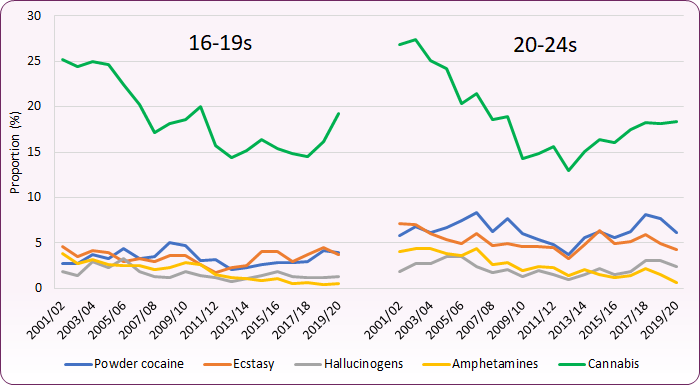 Source: Office for National Statistics, Drug Misuse Appendix Tables: Findings from the year ending March 2020 Crime Survey for England and Wales
Source: Office for National Statistics, Drug Misuse Appendix Tables: Findings from the year ending March 2020 Crime Survey for England and Wales
Whilst cannabis use accounts for much of the recent increase in overall prevalence, the last decade has also seen increases in the proportion of young people reporting cocaine and ecstasy use:
- Among 16 to 19 year olds, the proportion reporting use of powdered cocaine in the last year increased from 2.2% in 2012/13 to 4.1% in 2018/19 before falling slightly to 4% in 2019/20.
- Among 20 to 24 year olds the proportion increased from a low of 3.7% in 2012/13 to 8.1% in 2017/18 before falling to 6.1% in 2019/20.
- Of all 16 to 24 year olds who reported use of powdered cocaine in the past year, 9.4% reported frequent use, whilst 85.7% reported use between once every couple of months to once or twice a year.
- Among 16 to 19 year olds, the proportion reporting use of ecstasy in the last year increased from a low of 1.8% in 2011/12 to 4.5% in 2018/19, before falling to 3.7% in 2019/20.
- Among 20 to 24 year olds the proportion reporting ecstasy use increased from a low of 3.3% in 2012/13 to 5.9% in 2017/18 before falling to 4.2% in 2019/20.
Children and Young People's Reported Drug Use in Blackpool
Drug prevalence estimates from either the NHS Digital survey or the CSEW are not available for young people at a local level. Whilst not able to generate a Blackpool-wide prevalence estimate, the biennial survey 'Supporting the Health and Wellbeing of Young People of Blackpool' found that, in 2019:
- 17% of pupils surveyed in Years 8 to 10 (aged 12 to 15) had ever used illicit drugs. 10% reported use within the last month
- 26% of Year 10 pupils reported having used cannabis
- 25% of pupils reported having been offered cannabis, compared to 20% in 2017, 18% in 2015, and 19% in 2012
- 39% of Year 10 pupils had been offered cannabis
Drug Offences Among Under 25s in Blackpool
Police recorded drug offences may not be a reliable measure of overall drug prevalence among young people since they take place within a specific legislative framework, are subject to particular policing strategies and resources (e.g. locally targeted initiatives), and may also reflect illicit drug use that is more detectable. Offence data can, however, offer an insight into the type of offences taking place locally and any emerging trends in substances in use.
Between April 2021 and March 2022, 59% of offences for possession of a controlled drug among under 25s in Blackpool were for cannabis, whilst 32% were for cocaine. This compares to 77% cannabis and 15% cocaine across the wider Lancashire Constabulary area for the same period. For possession with intent to supply offences, 34% involved cannabis, 26% heroin, 19% crack and 11% cocaine. This is similar to the wider Lancashire area.
Drug Related Harms and Risk Groups
Some children and young people may use substances as a way of dealing with ongoing negative feelings and experiences, or the social and emotional impacts of childhood adversity or trauma2. Because of these factors, young people using substances, particularly those accessing specialist services, may be more likely to have wider issues and challenges that can affect or be associated with their substance use and any supportive response to their needs. These include:
- mental health treatment needs - 43% of young people accessing treatment across England in 2020/21 said they needed mental health treatment
- self-harming behaviour - 46% of females and 15% of males reported self-harm
- sexual exploitation - 12% of females and 2% of males reported sexual exploitation
- offending
- domestic abuse - 23% reported being affected by domestic abuse5
- being in care / a 'looked after child'
- not being in employment, education or training
Young people who experience these 'vulnerabilities' may also be more likely to engage in polydrug use, using multiple substances at the same time or sequentially within a specific time. Polydrug use can lead to increased health risks, including in some cases overdose (see JSNA Adult Substance Misuse section). 62% of females and 49% of males accessing treatment nationally in 2020/21 reported polydrug use.
Hospital Admissions
Note: Hospital admission statistics for the 2020/21 period may have been affected by COVID-19 disruption, both in terms of changes in admissions and in the quality and coverage of data, with hospitals in some areas reported significantly less activity from March 2020 onwards6.
In the period 2018/19 to 2020/21, 75 young people aged 15-24 were admitted to hopsital due to substance misuse, and the rate of hospital admissions was 167 per 100,000 (directly standardarised rate). This was the seventh highest rate in the country and more than double the England rate of 81 per 100,000. The Blackpool admission rate has declined since 2013/14 to 2015/16, when 174 young people were admitted to hospital and the rate was 344 per 100,000, the highest in the country (Figure 4).
Figure 4: Hospital Admissions Due to Substance Misuse (15 to 24 years), Blackpool, North West and England, 2008/09-10/11 to 2018/19-20/21
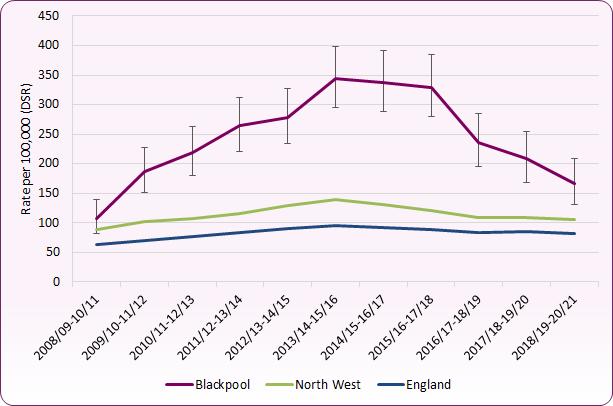 Source: Office for Health Improvement and Disparities (OHID) Public Health Profiles / Hospital Episode Statistics.
Source: Office for Health Improvement and Disparities (OHID) Public Health Profiles / Hospital Episode Statistics.
Admission rates for 15 to 24 year old females in Blackpool fell sharply between 2015/16-2017/18 and 2016/17-2018/19, and have reduced from 386 per 100,000 population between 2015/16 and 2017/18 to the current level of 152 per 100,000. Male admission rates have fallen steadily from 292 per 100,000 between 2013/14 and 2015/16 to the current level of 182 per 100,000. However, rates for both males and females remain significantly higher than the national average (Figure 5).
Figure 5: Hospital Admissions Due to Substance Misuse for Males and Females (15 to 24 years), Blackpool and England, 2010/11-12/13 to 2018/19-20/21
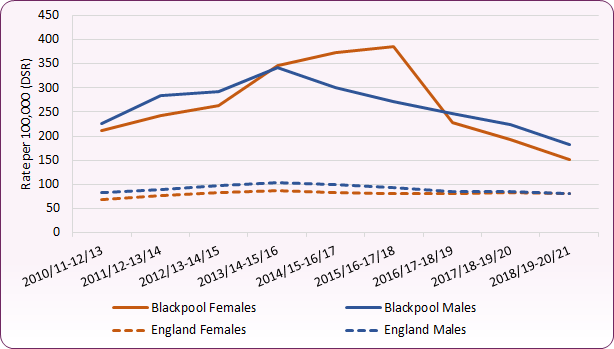 Source: Office for Health Improvement and Disparities (OHID) Public Health Profiles / Hospital Episode Statistics.
Source: Office for Health Improvement and Disparities (OHID) Public Health Profiles / Hospital Episode Statistics.
National hospital admission statistics suggest that there may also be aged-based variation in admissions. Across England the number of under-16 admissions for 'poisoning by drug misuse' increased by 24.5% between 2012/13 and 2019/20, whilst admissions for those aged 16 to 24 reduced by 12.5%6.
Looked After Children and Children in Need
Blackpool has the highest rate of looked after children in England. 2021 data from the Department for Education shows that 5% of 'Our Children' (looked after children) were identified as having a substance misuse problem, with 61% of these receiving an intervention to support them to address this. Nationally and regionally, 3% of the looked after population are identified as having a substance misuse problem (though relatively small numbers at the local level may affect comparisons).
In 2021, 10.7% of Children in Need episodes in Blackpool identified drug use by the child as a factor at the end of the assessment period, compared to 5.5% across England7.
School Exclusions and Suspensions
In the 2019/20 academic year approximately 40 school suspensions in Blackpool were related to drugs and alcohol. This represents 3% of overall suspensions, the same as the national rate for suspensions related to alcohol and drugs. This proportion has been similar over the last six years, both nationally and locally.
Drug Treatment for Children and Young People
Information about drug treatment services is compiled nationally by the National Drug Treatment Monitoring System (NDTMS). Regularly updated national and local drug treatment service data can be found at the NDTMS website.
Specialist drug treatment services for young people tend to be separate from adult services because young people's drug and alcohol issues and concerns tend to be different from adults', and the response needs to adopt a child-centred approach that considers the age and maturing of the person, acting on safeguarding issues where relevant. In Blackpool, support and treatment for children and young people aged 10 to 24 years old is provided by the Blackpool Adolescent Service.
Across England in 2020/21 there were 14,340 young people aged under 25 in young people's drug and alcohol misuse services, with around 11,000 (74%) of those under the age of 18 (this does not include young adults in adult treatment services). Numbers of young people attending specialist substance misuse services for both alcohol and drug treatment have fallen year-on-year since a peak of 24,494 in 2008 to 20095. This is due to a number of factors, including reduced funding for substance misuse treatment services, and generally reducing drug prevalence among children and young people in the early 2000s.
The number of under 18s in drug and alcohol treatment across England in 2020/21 was a 23% reduction from the pre-Covid 2019/20 period. Like other services, young people's substance misuse services were affected by the Covid-19 pandemic, particularly during its early stages and national lockdown periods. Most services had to restrict face-to-face contacts which affected the types of interventions provided. The impact on other services, particularly education and youth justice provision, also resulted in fewer referrals for treatment over this period.
In Blackpool in 2020/21 there were around 135 young people under 25 in drug and alcohol treatment services8. 40 (31%) of these were under 18 and 95 (69%) were aged between 18 and 24 years. The number of under-18s in drug and alcohol treatment declined between 2009/10 and 2017/18, before increasing in the last three years. Numbers of 18 to 24 years old in treatment have traditionally been low within the service, though have increased significantly since 2015/16 (Figure 6). There are a number of reasons for these patterns, some of which reflect national trends:
- Reductions in funding around school outreach and early intervention provision from 2009/10, resulting in fewer young people presenting with substance misuse concerns
- Declining numbers of alcohol presentations (and prevalence), locally and nationally
- A focus on trauma-informed services in recent years increasing the identification of and response to substance misuse in both under-18 and young adult services (social care, youth justice, leaving care services)
- Recent increase in multi-agency working and the introduction of Young ADDER, leading to improved referrals and joint responses
Figure 6: Numbers of Young People in Drug and Alcohol Treatment, Blackpool 2009/10 to 2020/21
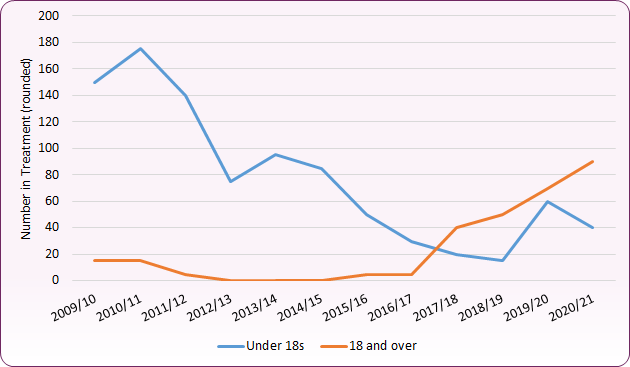 Source: National Drug Treatment Monitoring System (NDTMS), young person's data (ViewIt) / OHID, Young People Substance Misuse Commissioning Support Pack 2022-23:Key Data. Numbers rounded to nearest 5.
Source: National Drug Treatment Monitoring System (NDTMS), young person's data (ViewIt) / OHID, Young People Substance Misuse Commissioning Support Pack 2022-23:Key Data. Numbers rounded to nearest 5.
Drug services record the primary substance of concern for those entering treatment, together with additional or secondary substances of concern. In 2020/21, the primary substance of concern for 63% of under-25s in the Blackpool treatment service was cannabis. 22% of young people were in treatment primarily for alcohol concerns, and 6% for cocaine use. Other primary substances of concern for young people in treatment included heroin, ecstasy, ketamine, and solvents. The profile of primary substances differs between the under-18 treatment population and those aged 18 to 24 years. 81% of those aged under 18 were in treatment primarily for cannabis misuse in 2020/21 (78% nationally), compared to 55% of those aged 18 to 24 (54% nationally).
The gender profile of those in treatment also varies according to age group, with 76% of under-18s identifying as male, compared to 56% of those aged 18 to 24 (Figure 7). Nationally in 2020/21, 66% of under-18s and 59% of 18 to 24 year olds in treatment were male.
Figure 7: Gender Profile of Young People in Treatment, Blackpool, 2020/21
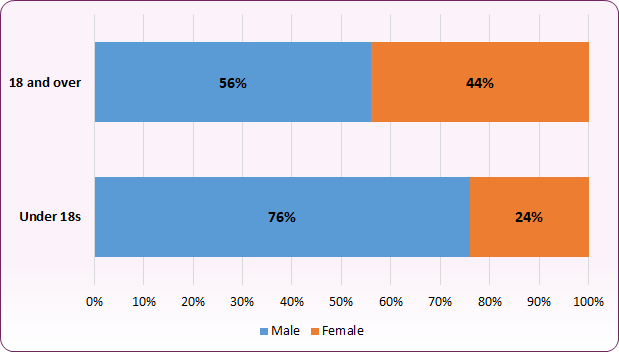 Source: National Drug Treatment Monitoring System (NDTMS), young person's data (ViewIt) / OHID, Young People Substance Misuse Commissioning Support Pack 2022-23:Key Data
Source: National Drug Treatment Monitoring System (NDTMS), young person's data (ViewIt) / OHID, Young People Substance Misuse Commissioning Support Pack 2022-23:Key Data
NDTMS data for 2020/219 also shows that, for under-18s in treatment:
- 62% were referred via Children and Family Services compared to 22% nationally. This is at least in part due to the integrated nature of Blackpool Adolescent Service
- 14% were referred from education services, compared to 25% nationally
- 43% were in mainstream education, and 36% were in alternative education (compared to 56% and 18% nationally)
- 83% were living with parents (82% nationally)
- 24% were identified as Children in Need (compared to 9% nationally)
- 45% started using drugs or alcohol before the age of 15 (early onset), similar to the national rate of 46%
- 17% identified as tobacco smokers at the start of treatment, compared to 27% nationally
- 90% reported having consumed no units of alcohol in the 28 days prior to commencing treatment, compared to 50% nationally
- 31% were identified as having a mental health treatment need at the start of treatment, compared to 42% nationally
- 74% successfully completed treatment, compared to 52% nationally. This equates to 94% of all those exiting treatment (79% nationally)
National and Local Strategy and Response
In 2021 the UK Government released From Harm to Hope: A 10-year drugs plan to cut crime and save lives (see also JSNA Adult Drug Misuse section). Within the strategy the government identified:
- increased treatment capacity
- the importance of school-based prevention and early intervention
- increased support for young people and families most at risk of substance misuse (including funding for the Supporting Families Programmes, expanded provision for looked after children, healthcare support in the secure estate, and increased access to mental health provision)
The national strategy is underpinned by strong local Combating Drugs Partnerships to reduce drug-related crime, harm, overall use, supply, and to increase engagement in treatment and improve long-term recovery. By the end of 2022 partnerships are expected to have a local drug strategy and delivery plan. Partners across Blackpool are working towards this, building on existing partnerships already formed through Project ADDER (and Young ADDER) and other local initiatives.
Advisory Council on the Misuse of Drugs (ACMD) (2006) Pathways to Problems: Hazardous use of tobacco, alcohol and other drugs by young people in the UK and its implications for policy.
Aynsley, A., Buchanan, L., Burrows, N. & Bush, M. (2017) Childhood adversity, substance misuse and young people’s mental health. Addaction / Young Minds.
Royal College of Paediatrics and Child Health (2020) State of Child Health: Alcohol and drug use in children and young people.
Dame Carol Black (2020) Review of Drugs: Executive Summary.
Office for Health Improvement & Disparities (OHID) (2022) Young people's substance misuse treatment statistics 2020 to 2021: report.
NHS Digital, Statistics on Drug Misuse, England 2020.
Department for Education (2021) Characteristics of Children in Need: 2020 to 2021.
Numbers are rounded to the nearest 5 to protect patient confidentiality and potential for the identification of individuals through deductive disclosure. Data presented for the Blackpool Adolescent Service includes all young people receiving treatment within the service. This may include a very small number of young people who live outside the Blackpool area, and similarly excludes a small number who may be resident in Blackpool but receive treatment elsewhere (e.g. in the secure estate or with another provider). It also excludes anyone under 25 who may be registered with adult treatment services.
Office for Health Improvement and Disparities (OHID) Young People Substance Misuse Commissioning Support Pack 2022-23: Key Data. Note: This data is restricted and information presented here is rounded and low values restricted in order to avoid deductive disclosure.